Is Your SEO “Future-Proof”? How to Build a Strategy That Survives Any Algorithm Change
Stop worrying about Google updates. Discover the proven framework for creating a future-proof SEO strategy that consistently delivers results, regardless of algorithm changes.
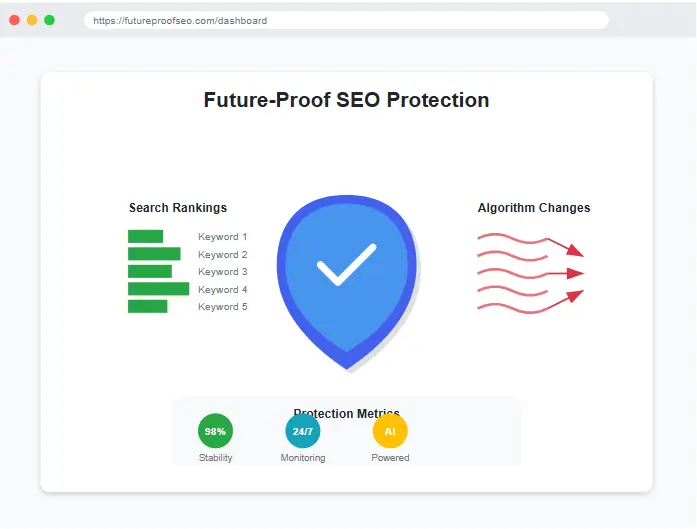
Building a future-proof SEO strategy protects your rankings from algorithm volatility
The Challenge of Modern SEO
Why traditional SEO approaches are failing in today’s rapidly changing digital landscape
In the ever-evolving world of search engine optimization, one question keeps digital marketers awake at night: “Is my SEO strategy future-proof?” With Google rolling out thousands of algorithm changes each year, businesses find themselves in a constant battle to maintain their search rankings. What worked yesterday might not work today, and what works today could be obsolete tomorrow.
This is where the concept of future-proof SEO comes into play. Unlike traditional SEO tactics that focus on exploiting current algorithm preferences, future-proof SEO is built on principles that transcend specific algorithm updates. It’s about creating a sustainable, long-term strategy that aligns with Google’s ultimate goal: providing the best possible experience for searchers.
In this comprehensive guide, we’ll explore how to build a future-proof SEO strategy that not only survives but thrives in the face of algorithm changes. You’ll discover the core principles that form the foundation of future-proof SEO, practical implementation strategies, and real-world examples of businesses that have successfully weathered major algorithm updates.
By the end of this guide, you’ll have a clear roadmap for transforming your SEO approach from reactive to proactive, from short-term gains to sustainable growth. Let’s dive into the world of future-proof SEO and build a strategy that stands the test of time.
The Problem with Traditional SEO
Why conventional SEO tactics leave you vulnerable to algorithm changes
For years, SEO has been a game of cat and mouse between marketers and search engines. As soon as marketers figure out what Google’s algorithm values, they optimize their sites accordingly. Then Google updates its algorithm to provide better results, and marketers have to adapt again. This cycle has led to several problems with traditional SEO approaches:
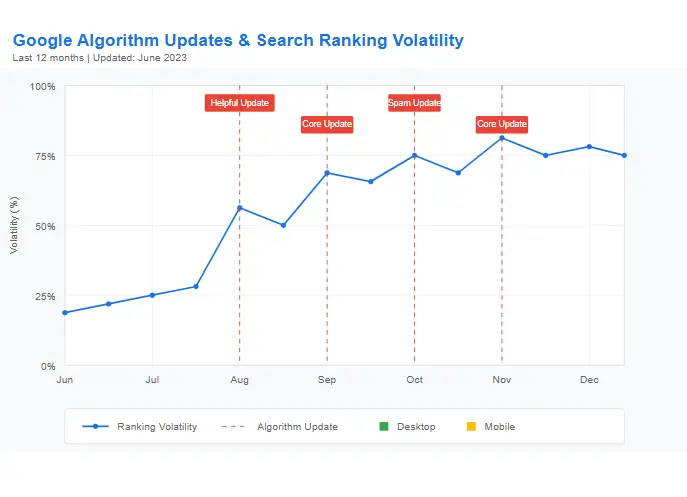
Search rankings often experience significant volatility during major algorithm updates
Short-term Focus
Traditional SEO often focuses on quick wins rather than sustainable growth. Tactics like keyword stuffing, link schemes, and content farms might deliver temporary results, but they’re exactly what Google’s algorithm updates aim to penalize. According to Google’s spam policies, these practices can result in severe penalties that are difficult to recover from.
Algorithm Dependency
When your SEO strategy is built around exploiting current algorithm preferences, you’re entirely dependent on those preferences remaining unchanged. This leaves you vulnerable to even minor algorithm updates. The history of SEO is filled with examples of businesses that saw their traffic disappear overnight due to algorithm changes.
Lack of User Focus
Many traditional SEO tactics prioritize search engines over actual users. This approach is fundamentally flawed because Google’s ultimate goal is to satisfy users, not marketers. Algorithms are increasingly sophisticated at detecting and devaluing content that doesn’t serve human needs.
Constant Adaptation Required
Following traditional SEO means you’re always playing catch-up. Every algorithm update requires a reassessment of your strategy, leading to inconsistent results and wasted resources. This reactive approach is exhausting and unsustainable for most businesses.
Penalty Risks
Many tactics that were once considered standard SEO practices are now explicitly against Google’s guidelines. Continuing to use these tactics puts your site at risk of manual penalties that can be devastating to your traffic and business. Recovery from such penalties can take months or even years.
Diminishing Returns
As search engines become more sophisticated, the effectiveness of traditional SEO tactics continues to decline. What once delivered significant results now provides minimal impact, requiring more effort for less reward. This diminishing return makes traditional SEO increasingly inefficient.
These problems highlight why a new approach is needed—one that focuses on creating lasting value rather than chasing algorithm preferences. This is the essence of future-proof SEO.
The Future-Proof SEO Solution
Building a strategy that aligns with search engines’ ultimate goals
Future-proof SEO is not about finding loopholes in Google’s algorithm or exploiting temporary ranking factors. Instead, it’s about creating a strategy that aligns with the fundamental principles that guide search engines’ evolution. By focusing on what search engines are trying to achieve rather than how they currently achieve it, you can build an SEO strategy that remains effective regardless of algorithm changes.
At its core, future-proof SEO is built on three fundamental pillars:
User-Centric Approach
Google’s ultimate goal is to provide users with the most relevant, helpful, and satisfying results for their queries. By prioritizing user experience and satisfaction in your SEO strategy, you’re aligning with Google’s fundamental objective. This means creating content that truly answers users’ questions, designing websites that are intuitive and easy to navigate, and ensuring your site provides value beyond what users expect.
Technical Excellence
While user experience is paramount, technical excellence ensures that search engines can properly crawl, index, and understand your content. This includes site speed, mobile-friendliness, structured data, and clean code architecture. These technical elements have consistently been important for SEO and will likely remain so as search engines continue to evolve.
Authority Building
Establishing your site as a trusted authority in your niche is crucial for long-term SEO success. This involves creating comprehensive, expert content, earning quality backlinks naturally, and building a brand that users and search engines trust. Authority is something that algorithms have consistently rewarded and will likely continue to reward in the future.
By focusing on these three pillars, you’re creating an SEO strategy that’s not dependent on specific algorithm preferences but rather on the fundamental principles that guide search engines’ evolution. This is the foundation of future-proof SEO.
In the following sections, we’ll dive deeper into each of these pillars and explore practical strategies for implementing them in your SEO efforts.
Core Principles of Future-Proof SEO
The fundamental concepts that will keep your strategy effective regardless of algorithm changes
Building a future-proof SEO strategy requires understanding and implementing several core principles. These principles form the foundation of an approach that transcends specific algorithm updates and focuses on creating lasting value for both users and search engines.
1. E-E-A-T: The Foundation of Trust
Google’s E-E-A-T (Experience, Expertise, Authoritativeness, and Trustworthiness) framework has become increasingly important in how search engines evaluate content. While initially focused on Your Money or Your Life (YMYL) topics, these principles now apply across all types of content. As Google’s quality guidelines emphasize, demonstrating E-E-A-T is crucial for achieving and maintaining high rankings.
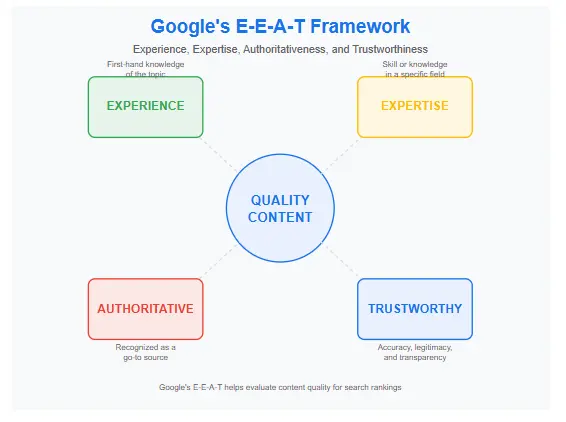
Google’s E-E-A-T framework forms the foundation of trustworthy content
To build E-E-A-T into your future-proof SEO strategy:
- Demonstrate real-world experience in your content
- Showcase expertise through comprehensive, accurate information
- Build authority by becoming a go-to resource in your niche
- Establish trustworthiness through transparency, accuracy, and reliability
By focusing on E-E-A-T, you’re aligning with Google’s goal of providing users with reliable, high-quality information—a goal that will only become more important as algorithms continue to evolve.
2. Topical Authority: Go Beyond Keywords
Traditional SEO often focused on targeting specific keywords, but future-proof SEO emphasizes building topical authority. This means creating comprehensive content that covers a topic in depth, addressing related subtopics and answering questions users might have.
To build topical authority:
- Create content clusters around core topics
- Develop pillar pages that comprehensively cover broad topics
- Link related content internally to establish topical connections
- Regularly update and expand your content to keep it current
Search engines are increasingly sophisticated at understanding topical relationships and rewarding sites that demonstrate comprehensive coverage of a subject. This approach is less vulnerable to algorithm changes because it’s based on providing genuine value rather than targeting specific keywords.
3. User Experience Signals: The Hidden Ranking Factors
While Google has stated that user experience signals like Core Web Vitals are important ranking factors, the reality is that user experience has always been crucial to SEO, even when it wasn’t explicitly measured. Future-proof SEO prioritizes user experience because it aligns with search engines’ ultimate goal of satisfying users.
Key aspects of user experience to focus on include:
- Page speed and loading times
- Mobile-friendliness and responsive design
- Intuitive navigation and site structure
- Readability and content formatting
- Minimizing intrusive pop-ups and ads
By prioritizing user experience, you’re not only improving your potential for better rankings but also increasing the likelihood that visitors will engage with your content, return to your site, and become customers.
4. Content Quality Over Quantity
In the early days of SEO, content quantity often trumped quality. Sites could rank by publishing large volumes of mediocre content. Today, and certainly in the future, the opposite is true. Future-proof SEO focuses on creating high-quality, comprehensive content that provides genuine value to users.
Characteristics of high-quality content include:
- Comprehensive coverage of the topic
- Original insights and perspectives
- Practical, actionable information
- Engaging formats like visuals, videos, and interactive elements
- Regular updates to ensure accuracy and relevance
By focusing on quality over quantity, you’re creating content that users will find valuable, share, and reference—signals that search engines will likely continue to reward regardless of algorithm changes.
5. Natural Link Building Through Value Creation
Link building has always been a crucial aspect of SEO, but the approach has evolved significantly. Future-proof SEO focuses on earning links naturally by creating valuable content and resources that others want to reference and share.
Strategies for natural link building include:
- Creating original research and data
- Developing comprehensive guides and resources
- Building tools and calculators
- Creating visually appealing infographics and data visualizations
- Offering expert insights and quotes to journalists and bloggers
This approach to link building is more sustainable and less vulnerable to algorithm changes because it’s based on creating genuine value rather than manipulating search rankings.
6. Technical SEO as a Foundation
While content and user experience are crucial, technical SEO provides the foundation that allows search engines to properly crawl, index, and understand your site. Future-proof SEO includes a strong technical foundation that ensures your content can be effectively discovered and evaluated by search engines.
Key technical SEO elements include:
- Clean site architecture and logical URL structure
- Proper use of header tags and semantic HTML
- Optimized robots.txt and XML sitemaps
- Structured data markup
- Secure HTTPS protocol
- Fast loading times and optimized images
These technical elements have consistently been important for SEO and will likely remain so as search engines continue to evolve. By ensuring your site has a strong technical foundation, you’re creating a platform that can effectively support your content and user experience efforts.
7. Adaptability and Continuous Learning
Perhaps the most important principle of future-proof SEO is adaptability. The digital landscape is constantly changing, and what works today might not work tomorrow. Future-proof SEO requires a mindset of continuous learning and adaptation.
To cultivate adaptability in your SEO strategy:
- Stay informed about industry trends and algorithm updates
- Regularly analyze your performance data and adjust your strategy accordingly
- Experiment with new approaches and tactics
- Focus on principles rather than specific tactics
- Build a diverse traffic portfolio that doesn’t rely solely on organic search
By embracing adaptability, you’re preparing your SEO strategy to evolve alongside search engines, ensuring long-term success regardless of what changes the future may bring.
Implementing Your Future-Proof SEO Strategy
Practical steps to transform your approach and build a strategy that lasts
Understanding the principles of future-proof SEO is one thing, but implementing them effectively is another. In this section, we’ll walk through a step-by-step process for building and executing a future-proof SEO strategy for your business.
Step 1: Conduct a Comprehensive SEO Audit
Before implementing a new strategy, it’s essential to understand where you currently stand. A comprehensive SEO audit will help you identify strengths, weaknesses, and opportunities in your current approach. Tools like Ahrefs’ Site Audit can provide valuable insights into your site’s technical health and optimization opportunities. For a thorough evaluation of your site’s technical foundation, consider our detailed technical SEO audit service.
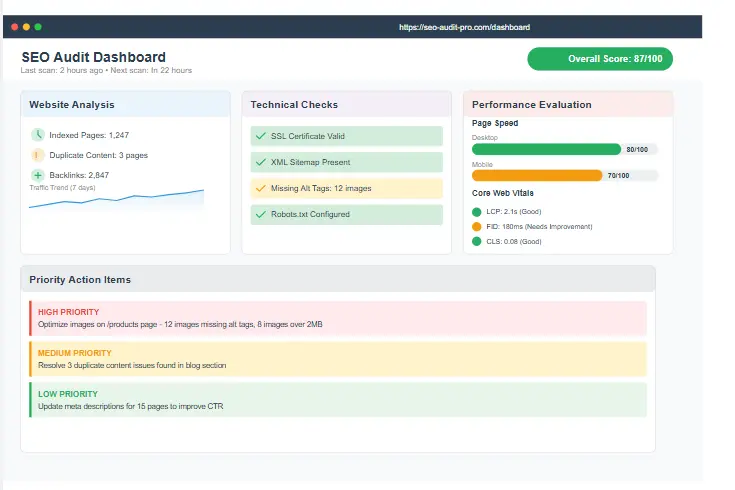
A comprehensive SEO audit is the first step in building a future-proof strategy
Your audit should include:
- Technical SEO analysis (site speed, mobile-friendliness, crawlability, etc.)
- Content audit (quality, relevance, comprehensiveness, E-E-A-T signals)
- Backlink profile analysis (quality, relevance, diversity of links)
- User experience assessment (navigation, layout, engagement metrics)
- Competitor analysis (what are they doing well, where are their weaknesses)
Use the results of your audit to prioritize areas for improvement and set realistic goals for your future-proof SEO strategy. For a comprehensive approach, our advanced SEO audit checklist can guide you through every aspect of the evaluation process.
Step 2: Define Your Core Topics and Target Audience
Future-proof SEO starts with a clear understanding of your target audience and the topics that matter to them. Instead of focusing solely on keywords, identify the core topics that align with your business and provide value to your audience.
To define your core topics:
- Identify your audience’s pain points, questions, and needs
- Map these needs to topics where your business can provide genuine value
- Research how these topics are currently being addressed in search results
- Identify gaps and opportunities to provide better, more comprehensive content
By focusing on topics rather than keywords, you’re building a strategy that’s aligned with user needs rather than search engine preferences.
Step 3: Develop a Content Architecture Built on Topical Authority
Once you’ve identified your core topics, develop a content architecture that establishes your site as an authority on these subjects. This typically involves creating content clusters around pillar pages.
Your content architecture should include:
- Pillar pages that comprehensively cover broad topics
- Cluster content that addresses specific subtopics and questions
- Internal linking strategies that establish topical relationships
- A plan for regularly updating and expanding your content
This approach helps search engines understand your expertise on a topic and provides users with a comprehensive resource that addresses their needs.
Step 3: Create High-Quality, Comprehensive Content
With your content architecture in place, it’s time to create the actual content. Focus on quality over quantity, ensuring each piece provides genuine value to your audience.
When creating content:
- Aim for comprehensiveness, covering all relevant aspects of the topic
- Include original insights, data, or perspectives
- Make content engaging with visuals, examples, and interactive elements
- Ensure content is well-structured and easy to read
- Demonstrate E-E-A-T signals through author expertise, citations, and transparency
Remember that creating high-quality content takes time and resources, but the investment pays off in better rankings, more engaged users, and a stronger foundation for future-proof SEO.
Step 4: Optimize Technical SEO Elements
With your content strategy in place, ensure your technical SEO foundation supports your efforts. Address any issues identified in your audit and implement best practices for technical SEO.
Key technical optimizations include:
- Improving page speed and Core Web Vitals
- Ensuring mobile-friendliness and responsive design
- Implementing structured data markup
- Optimizing URL structure and internal linking
- Creating and submitting XML sitemaps
- Fixing crawl errors and optimizing robots.txt
These technical elements ensure that search engines can properly crawl, index, and understand your content, providing a solid foundation for your future-proof SEO strategy.
Step 5: Implement a Natural Link Building Strategy
With high-quality content in place, focus on earning links naturally by creating resources that others want to reference and share. This approach is more sustainable and less vulnerable to algorithm changes than traditional link building tactics.
Strategies for natural link building include:
- Promoting your content to relevant audiences and communities
- Reaching out to journalists and bloggers with expert insights
- Creating shareable visuals and data visualizations
- Developing tools and resources that provide ongoing value
- Building relationships with others in your industry
Remember that natural link building is a long-term strategy that requires patience and consistency, but the results are more sustainable and valuable than quick-win tactics.
Step 6: Monitor, Analyze, and Adapt
Future-proof SEO is not a set-it-and-forget-it strategy. Regular monitoring and analysis are essential to understand what’s working, what’s not, and how you need to adapt your approach. SEO analytics tools can help you track performance and identify trends that inform your strategy adjustments.
Key metrics to monitor include:
- Organic traffic and rankings for core topics
- User engagement metrics (time on page, bounce rate, pages per session)
- Conversion rates from organic traffic
- Backlink acquisition and quality
- Technical SEO performance (site speed, crawl errors, etc.)
Use these insights to continuously refine and improve your strategy, ensuring it remains effective as search engines and user behaviors evolve.
Step 7: Diversify Your Traffic Sources
While SEO is important, relying solely on organic search traffic leaves you vulnerable to algorithm changes. A truly future-proof strategy includes diversifying your traffic sources to build resilience against changes in any single channel.
Consider these additional traffic sources:
- Email marketing and newsletter subscribers
- Social media platforms relevant to your audience
- Paid advertising (search, social, display)
- Referral traffic from partners and industry sites
- Direct traffic through brand building and community engagement
For businesses with physical locations, implementing a robust local SEO strategy can provide a stable source of targeted traffic that’s less susceptible to algorithm fluctuations. By diversifying your traffic sources, you’re building a more resilient business that can withstand changes in search algorithms or other external factors.
Case Studies: Future-Proof SEO in Action
Real-world examples of businesses that have successfully weathered algorithm changes
Theory is valuable, but seeing future-proof SEO in action provides practical insights into how these principles translate to real-world success. Let’s explore three case studies of businesses that have implemented future-proof SEO strategies and successfully navigated major algorithm changes.
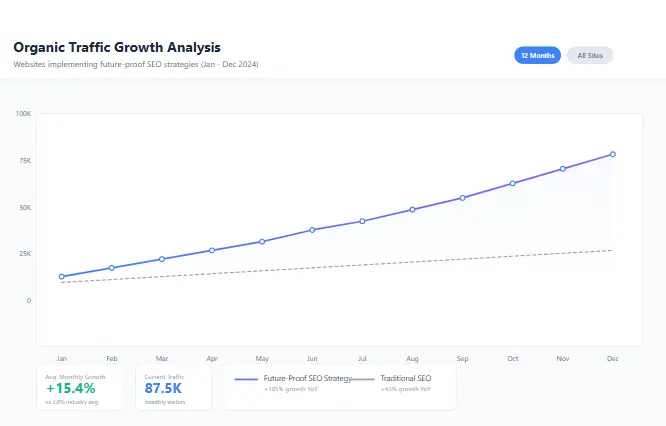
Websites with future-proof SEO strategies show stable growth despite algorithm updates
“When Google rolled out the Core Web Vitals update, many of our competitors saw significant drops in rankings. Our focus on user experience and technical SEO meant we not only maintained our rankings but actually saw an increase in organic traffic. Our future-proof approach to SEO has been invaluable for our business stability.”
– Sarah Johnson, Marketing Director at TechSolutions Inc.“After being hit by the Panda update years ago, we completely restructured our SEO approach to focus on E-E-A-T and topical authority. It was a lot of work initially, but when the Helpful Content Update rolled out, we were prepared. Our traffic has been stable through multiple major updates, and we’ve even seen growth during periods when others were struggling.”
– Michael Chen, CEO of HealthInfo Hub“We used to focus heavily on keyword optimization and link building tactics that worked in the short term. After a penalty that nearly destroyed our business, we shifted to a future-proof SEO strategy focused on creating genuine value. It took time to recover, but now our rankings are more stable than ever, and we’re not constantly worried about the next algorithm update. Understanding Google’s algorithm history helped us realize that focusing on user value is the only sustainable approach.”
– David Rodriguez, Founder of E-commerce StoreThese case studies illustrate the power of a future-proof SEO approach. By focusing on creating genuine value for users and building authority in their respective niches, these businesses have created SEO strategies that withstand algorithm changes and deliver consistent results over time.
Frequently Asked Questions About Future-Proof SEO
Answers to common questions about building a strategy that survives algorithm changes
How long does it take to implement a future-proof SEO strategy?
Implementing a future-proof SEO strategy is not a quick fix but a long-term approach. While some initial improvements can be seen within a few months, building true topical authority and establishing your site as a trusted resource typically takes 6-12 months of consistent effort. The good news is that the results of a future-proof approach tend to be more sustainable and cumulative over time.
Is future-proof SEO more expensive than traditional SEO?
Initially, implementing a future-proof SEO strategy may require more investment in terms of time and resources, particularly if you need to create high-quality content or address technical issues. However, in the long run, it’s often more cost-effective because you’re not constantly reacting to algorithm changes or recovering from penalties. The sustainable nature of future-proof SEO means you’re building value that compounds over time.
Do I still need to pay attention to keywords with future-proof SEO?
Yes, keywords are still important in future-proof SEO, but the approach is different. Instead of focusing on individual keywords, you’re thinking about topics and the questions users have. Keyword research helps you understand what your audience is searching for, but your content should comprehensively address the topic rather than targeting specific keyword densities. This topic-based approach is more aligned with how search engines now understand content.
How do I know if my current SEO strategy is future-proof?
Evaluate your current strategy against the principles of future-proof SEO. Are you focusing on creating genuine value for users? Are you building topical authority rather than just targeting keywords? Is your site technically sound and user-friendly? If your approach relies heavily on tactics that exploit current algorithm preferences or if you’re constantly worried about updates, it’s probably not as future-proof as it could be.
Can small businesses compete with larger companies using future-proof SEO?
Absolutely. In fact, future-proof SEO can level the playing field for small businesses. While larger companies may have more resources, small businesses can often be more nimble and focused. By identifying specific niches where you can provide exceptional value and building authority in those areas, you can compete effectively regardless of company size. The focus on quality and user experience rather than sheer volume of content or links benefits businesses of all sizes.
How often should I update my future-proof SEO strategy?
A future-proof SEO strategy should be reviewed and refined regularly, but completely overhauled much less frequently than traditional SEO approaches. Plan to review your performance data monthly, make tactical adjustments quarterly, and evaluate your overall strategy annually. The core principles of future-proof SEO should remain consistent, but the specific tactics and priorities may evolve based on performance data and industry changes.
Ready to Future-Proof Your SEO Strategy?
Don’t leave your search rankings to chance. Build a strategy that withstands any algorithm change and delivers consistent, sustainable results.